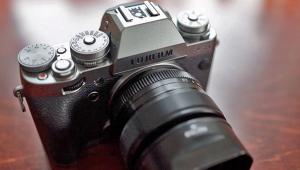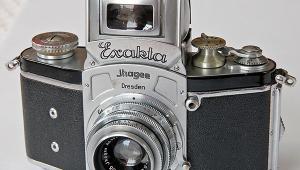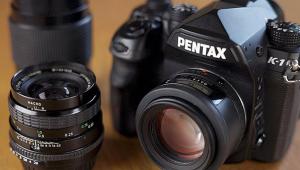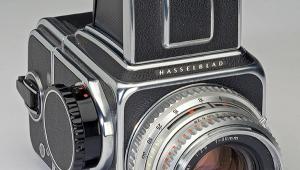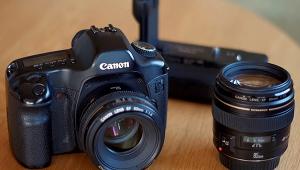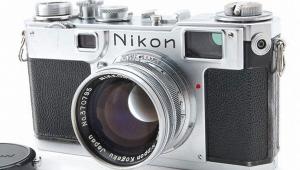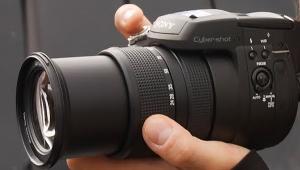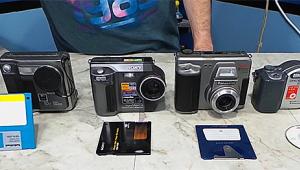Classic Cameras; The Top 20 Cameras Of All-Time Countdown; We Begin Schneider’s List—Do You Agree?
Contributor Jason Schneider is a world-recognized expert on Classic Cameras, so when he approached us with the idea to present a Top 20 Cameras of All-Time list we readily agreed. Rather than give you the entire list in one issue--which would probably have taken the lion's share of our editorial pages--we decided to present the list in countdown form, starting from 20 and working our way down in increments of five in subsequent issues. We have also created a Forum site for discussion on this topic, which we are sure will stir some debate: go to www.shutterbug.com and click on Forums to join in. So, we'll begin with Schneider's premise and first five of the Top 20 Cameras of All-Time.--Editor
What are the greatest cameras of all-time? The answers to this fascinating question depend largely on the criteria used to select them, namely how do you define a "great" camera. Ultimately, both the criteria and the selection process are inherently subjective, which means I expect to receive impassioned arguments on my choices and rankings. I have given special priority to cameras that are the first of their kind and have, in my judgment, had a profound influence on camera design, technology, and marketing. But I have also included "ultimates" of particular types of cameras, and others that have served as influential exemplars for the photographic world.
What's missing from this list of greats? Historical cameras like those of Daguerre, Niepce, and other pioneers, one-off wonders or those made in small quantities, ingenious oddball designs that do not rise to the level of "ultimates," and of course, many fine and wonderful cameras rightly regarded as classics. I have also excluded view cameras, which have certainly had a profound and continuing influence on photography, because no small number of examples stood head and shoulders above the rest. Could I include the Deardorff without listing the Ansco, Graphic View, Linhof Kardan, Sinar, Calumet, and a dozen others? Non-interchangeable lens rangefinder 35s and box cameras posed similar dilemmas, and I have included far fewer of each than I would have liked. As for digital cameras, I have done my best to put them in historical perspective, but this is a pretty dicey proposition when dealing with a relatively recent and rapidly emerging technology.
Despite all my qualms, dear readers, I have courageously committed my list of the Top 20 Cameras of All-Time to the judgment of posterity and will stoically endure all the loose lens caps and rotten tomatoes you can throw at me. In any case, I sure hope you enjoy this, and please feel free to send your bouquets, brickbats, and suggestions to me in the Top 20 Forum at www.shutterbug.com.
--Jason Schneider
 |
20) Kodak Instamatic 100--1963
The first of a long line of Kodak Instamatic cameras, the basic Instamatic 100 was a simple snapshot camera based on the Kodapak 126 cartridge, an easy-loading system that was virtually foolproof and eliminated the need to thread the film leader onto a take-up spool. The plastic 126 cartridge, which only fit into the camera when correctly oriented, provided a nominal 28x28mm format on paper-backed 35mm film that was masked down to an actual format size of 26.5mm square. The film featured one registration hole (perforation) per image, and frame numbers were read out in a small window at the rear of the cartridge. The system was enormously successful--by 1970 Kodak alone had manufactured over 50 million Instamatics--and dozens of camera-making companies in the US, Japan, and Germany offered 126 cartridge cameras, mostly simple snapshot cameras, but many with more advanced features. Kodak, Rollei, Zeiss Ikon, and Ricoh even fielded interchangeable lens 126 SLRs, though their performance, especially with fast lenses, was limited by the 126 cartridge's inherent limitations in providing good film flatness. It was probably the technical success of easy-loading, fully automatic 35mm point-and-shoot cameras in the late '70s that hastened the demise of the format, and the system petered out in the '80s. Kodak ceased manufacturing 126 Instamatic cartridges in 2000.
The cute little plastic-bodied Instamatic 100 features a fixed-focus 43mm f/11 acrylic lens, a simple two-speed (1/40 and 1/90 sec) shutter, top-mounted film-wind lever, and a pop-up flash designed for baseless AG-1 flash bulbs, and sold for $15.95 list. It provided the basis for an extensive series of Instamatics with spring motor drive, flash cube sockets, rangefinders, faster lenses, etc. An original Kodak Instamatic 100 is a collectible that's fairly easy to find, but not in perfect condition. Price of a pristine example is about $25; Mint 100s in original box have gone for as much as $50.
 |
19) Reflex-Korelle--1935
While the Korelle cannot claim honors as the first interchangeable lens 6x6cm (21/4 square) SLR, it was certainly one of the most successful and influential ones. It was made by Franz Kochman of Dresden, Germany, which became Korellewerke KG in 1939 and Korellewerk G.H. Brandtmann & Co. in '40. A Spartan waist-level SLR with hinged back and viewing hood with magnifier, the original Korelle features a 42mm threaded lens mount, and a cloth focal-plane shutter with speeds from 1/10 to 1/1000 sec that's set via two top-mounted dials that rotate as the shutter fires. To the left of the finder is a distinctive flip-up chrome film-wind crank with a built--in automatic film counter directly in front of it (you had to position the first frame in ye olde red window). The reflex mirror returns to viewing position by gravity as you relax finger pressure on the right-hand shutter release. Later models have shutter speeds from 1/25 to 1/500 sec and a more expensive deluxe model has speeds down to 2 seconds to 1/500 sec, a mirror lock that doubles as a self-timer release. Model III has a top speed of 1/1000 sec.
 |
The Korelle was very popular in the '30s and '40s and sired the post-World War II Meister Korelle (Master Reflex in the US). What's more important, the Korelle's basic design and configuration was carried forth and developed in the early and late models of the Exakta 66, Pentacon 6, and Praktisix, plus the Japanese Norita 66 and the Ukrainian Kiev 60. It also exerted a strong influence on the design of the still-current Pentax 67II. Today, all Korelles are considered collector's pieces. A clean, functional original model with uncoated 75mm f/2.8 Schneider Xenar manual diaphragm goes for about $300.
 |
18) Hansa Canon--1935
The first high-quality 35mm rangefinder camera produced in Japan, the Hansa Canon "precision miniature" was an early harbinger of things to come for the Japanese photographic industry, and it is significant that two of Japan's leading camera companies, Canon and Nikon, had a hand in creating it. Most were assembled at Seiki Kogaku, Kenkyujo, under the supervision of Nippon Kogaku (Nikon) between 1935 and '37. Though generally considered Canon's first commercial camera, it was fitted with a collapsible 50mm Nikkor lens (most commonly a 50mm f/3.5, but 50mm f/4.5 and f/2 lenses were also made in small quantities), and Nippon Kogaku also made the rangefinder, the unique pop-up viewfinder (reportedly to get around Leica patents), and the bayonet lens mount, which is quite similar to the one used on the later Nikon S. Other unique features include a half dollar-sized frame counter on the front and a milled, index finger focusing wheel on the lens, reminiscent of those on Contax bodies and the lens mounts of the American-made Kardan 35mm rangefinder camera.
